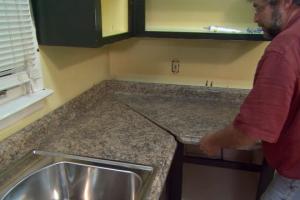Ultimate Guide to Replacing Your Countertops: A Step-by-Step Approach

-
Quick Links:
- Introduction
- Choosing the Right Materials
- Measuring Your Space
- Removing Existing Countertops
- Installing New Countertops
- Finishing Touches
- Maintenance Tips
- Case Studies
- Expert Insights
- FAQs
Introduction
Countertops are one of the most essential elements of any kitchen or bathroom. They serve not only as functional surfaces for cooking and preparation but also as a central aesthetic feature of your space. Over time, countertops can wear down, become outdated, or simply not match your design vision. This is where the idea of replacing them comes in. In this guide, we will explore everything you need to know about replacing countertops, from choosing the right materials to the installation process itself.
Choosing the Right Materials
When it comes to replacing countertops, the material you choose can significantly impact both the functionality and aesthetics of your space. Here are some popular materials along with their pros and cons:
- Granite: Durable and heat-resistant, available in various colors, but can be expensive and requires sealing.
- Quartz: Non-porous, very durable, and low maintenance, but can be costly and sensitive to heat.
- Laminate: Affordable and available in numerous designs, but less durable and can be damaged by heat and moisture.
- Marble: Elegant and timeless, but porous and can stain easily.
- Butcher Block: Warm and inviting, ideal for food preparation, but requires regular maintenance and can be scratched.
Consider factors like your budget, style preference, and how much wear and tear your countertops will endure when making your decision.
Measuring Your Space
Accurate measurements are crucial for a successful countertop replacement. Here's how to measure your space properly:
Tools You Will Need:
- Tape measure
- Pencil and paper for notes
- Level
- Square
Steps to Measure:
- Measure the length and width of each section of your countertop.
- Take note of any cutouts for sinks or appliances.
- Check for level surfaces and note any discrepancies.
- Record all measurements and double-check for accuracy.
Removing Existing Countertops
Before installing new countertops, you must safely remove the old ones. Follow these steps:
Safety Precautions:
- Wear safety goggles and gloves.
- Ensure all utilities (water and electricity) are turned off.
- Clear the workspace of any items or hazards.
Steps to Remove Old Countertops:
- Disconnect plumbing fixtures and appliances.
- Loosen and remove any screws or brackets securing the countertop to the cabinets.
- Carefully lift the countertop off the base, using assistance if necessary.
- Clean the surface of the cabinets to prepare for the new installation.
Installing New Countertops
Now that you have removed the old countertops, it's time to install the new ones. Here’s how:
Preparation:
- Ensure the cabinets are level and structurally sound.
- Gather all necessary tools and materials.
Steps for Installation:
- Place the new countertop on the cabinets, ensuring it fits properly.
- Secure the countertop using screws or brackets as needed.
- Install any cutouts for sinks or appliances.
- Seal joints and seams with caulk to prevent moisture penetration.
Finishing Touches
After installation, there are a few finishing touches to consider:
- Reattach plumbing fixtures and appliances.
- Clean the countertop surface thoroughly.
- Apply any protective coatings or sealants if necessary.
Maintenance Tips
To keep your countertops looking new, follow these maintenance tips:
- Use coasters and cutting boards to prevent damage.
- Clean spills immediately to avoid stains.
- Re-seal surfaces regularly if applicable.
Case Studies
Here are some real-world examples of successful countertop replacements:
Case Study 1: Kitchen Renovation
A family opted for quartz countertops in their kitchen renovation, enhancing the space's aesthetic while providing durability. The installation process took two days, and they reported a significant increase in their home's value.
Case Study 2: Budget-Friendly Upgrade
On a limited budget, a homeowner chose laminate for their countertops. The DIY installation saved them thousands, and they were pleased with the variety of design options available.
Expert Insights
According to home improvement experts, investing in high-quality materials can save you money in the long run. Additionally, professional installation can ensure longevity and reduce the risk of damage during the process.
FAQs
1. How much does it cost to replace countertops?
The cost varies widely based on materials and installation, ranging from $20 to $200 per square foot.
2. Can I install countertops myself?
Yes, many homeowners choose to DIY, especially with laminate or butcher block. However, some materials like granite may require professional installation.
3. How long does it take to replace countertops?
The process can take anywhere from a few hours to several days, depending on the complexity of the installation and the material chosen.
4. What should I do if my countertop is damaged?
Assess the damage; minor scratches can often be repaired with a sealant, while significant damage may require replacement.
5. Are there eco-friendly countertop options?
Yes, materials like recycled glass or bamboo are great eco-friendly alternatives.
6. How do I clean my new countertops?
Use a mild detergent and water; avoid harsh chemicals that can damage the surface.
7. What are the most durable countertop materials?
Granite and quartz are known for their durability and resistance to scratches and heat.
8. Can I mix different countertop materials in my kitchen?
Absolutely! Mixing materials can create a unique and personalized look.
9. Should I seal my countertops?
Depending on the material, sealing may be necessary to protect against stains and moisture.
10. What is the best material for a busy kitchen?
Quartz is an excellent choice for high-traffic kitchens due to its durability and low maintenance.